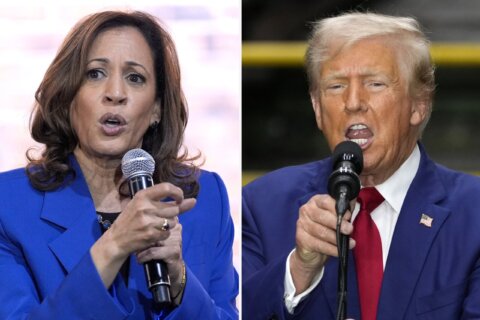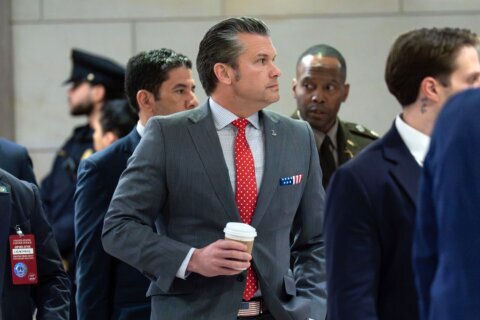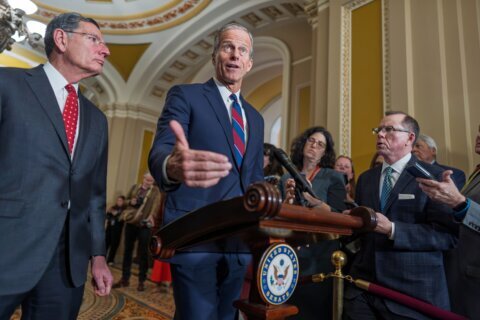As the end of the 2020 election draws near, the potential threat of disruption at the polls on the part of so-called militia groups is intensifying. And one local group is trying to make sure that, across the country, voters know their rights and law enforcement knows their responsibilities.
The Institute for Constitutional Advocacy and Protection, based at the Georgetown University Law School in D.C., has published a state-by-state series of 50 fact sheets regarding what is and isn’t allowed with regard to gathering inside and outside voting sites.
On Wednesday, they published guidance for law enforcement officials.
Each state has different laws, but there are three common threads: Private militias are not legal; a group doesn’t have to call itself a militia to be acting as one; and intimidation is in the eye of the voter.
“The only lawful militia is a state militia, and that’s based on historic text of the Constitution and Supreme Court interpretations,” Mary McCord, a former acting assistant attorney general for national security and legal director of the institute, said at a briefing Monday.
Local reaction
After the first presidential debate, at which President Trump has been telling supporters to “go into the polls and watch very carefully,” the attorneys general of D.C., Maryland and Virginia issued statements and opinions reminding residents that there is a process for people who want to become official poll watchers, and that no one has the right to simply turn up at a voting site and assume the right to decide whether things look legit.
“Federal law prohibits the military and armed federal law enforcement officers from being present at a poll site unless it is necessary to ‘repel armed enemies of the United States,’” said D.C. Attorney General Karl Racine in a statement, adding that “District law also expressly prohibits anyone from interfering with voter registration or voting itself.”
Virginia’s Mark Herring said that state law prohibits anyone from conducting themselves “in a noisy or riotous manner at or about the polls so as to disturb the election.”
It also bans “’threats, bribery, or other means in violation of the election laws’ to ‘attempt[] to influence any person in giving his vote or ballot or . . . deter him from voting.’”
And Maryland’s Brian Frosh said: “Voter harassment and intimidation is illegal and will not be tolerated in Maryland. Anyone attempting to violate these laws will be held accountable and prosecuted.”
He gave examples of intimidation that included spreading misinformation about voting and voter fraud; confronting voters while wearing “military-style” or “official-looking” uniforms; following voters to, from or within a polling place; writing down voters’ license plates; and “aggressively” questioning voters’ qualifications.
‘We are starting to see more’
McCord said some groups are taking Trump’s words seriously.
“We are starting to see more of that type of chatter” from national and local groups about turning out for Election Day. “And they’ve also been talking about all the musters and trainings that they’re undergoing right now in preparation for the post-Election Day period.”
While there are such groups on the left, McCord said, there are “fewer than there are on the far right.” They’ve also seen “straight-up anarchist groups that don’t easily fall on the left or right.”
Still, she specifies, “to be honest, it’s made much more difficult when we can’t rely on the president to denounce this type of activity.”
She added, “There are groups that are going to self-activate in the streets. And so this is one of the things that we’re trying to help local jurisdictions prepare for by making sure that at all levels, people are aware of the prohibitions on this activity. This is not constitutional, and it’s not protected by the Second Amendment.”
What makes a militia?
Amy Marshak, of the institute, pointed out that it’s important to remember that the question of whether a group does not have to declare itself a private militia to be acting as one.
“It’s not that it’s whether you go by a certain title or you name your militia or anything like that,” Marshak said.
“It’s that you’re acting as a military group … you’re exerting the impression that you can use force to compel people to act, that you are acting in a coordinated fashion, those kinds of things would be not permitted.”
Supreme Court decisions on the matter of private militias date back to 1886, Marshak said. She added that while the 2008 case D.C. v. Heller established the right of individuals to bear arms despite the appearance of the phrase “well-regulated militia” in the Second Amendment, even in that case the state’s ability to ban people from acting as a militia — to “associate together as military organizations, or to drill or parade with arms in cities and towns unless authorized by law” — was explicitly unchallenged.
Even though she’s sounding a warning, McCord said, “I don’t want to be apocalyptic about this. I think that it’s likely that what we would see would be isolated incidents in certain jurisdictions.”
Still, one or two incidents can get magnified on social media, “and it’s sort of makes it look like it’s a bigger, more nationwide problem than it is. I mean, we certainly saw this after George Floyd was killed, when, even though by far the vast majority of the racial justice protests have been entirely peaceful, it just takes a few to have acts of violence that goes viral. And then people have the impression that we have violence across the country.”
What to look for
If you see any group of people looking threatening at a polling place, the institute advises that first you document what you’re seeing, addressing these specific questions:
-
-
- What are they doing?
- What are they wearing?
- Are they carrying firearms? If so, what type? If not, are they carrying other types of weapons?
- Are they wearing insignia? If so, what does it say or look like?
- Are they bearing signs or flags?
- Do they seem to be patrolling like a law enforcement officer might do?
- Do they seem to be coordinating their actions?
- Do they have a leader?
- Are they stopping or talking to people outside of their group?
- Do they appear to be provoking or threatening violence? If so, what are they doing specifically?
- Are people turning away from the polling station after seeing or speaking with them?
-
What to do
In Virginia
If you see voter intimidation at a polling place, Herring’s office wants you to call them at 800-552-9745 or visit the Virginia Department of Elections’ website.
In Maryland
Frosh’s office said that “If you believe that you have witnessed or experienced voter intimidation, or that such conduct is imminent, please call the Office of the Attorney General at 443-961-2830 or toll free at 833-282-0960, or by email at electionswork@oag.state.md.us.”








